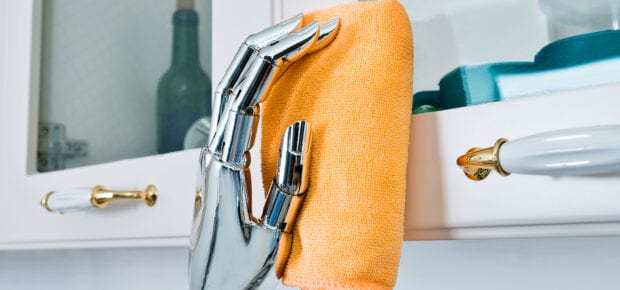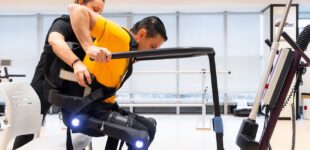October 26, 2020
Guests at hotels expect a welcoming reception, pleasant and well-arranged lobby and a spotless, comfortable room to use overnight during their travels. But as COVID-19 spread throughout the globe, to ensure their safety and reduce their risk of contracting the virus, guests’ demand for cleanliness amplified. Likewise, hotel managers and cleaning crews need greater safety measures while also ensuring where we stay is sanitary, so we are now turning to self-cleaning robots to help.
“Hotels, while being a necessity for many who travel, can be hazardous given the high rotativity and the diverse origin of guests,” says IEEE Graduate Student Member Hector Azpúrua. “In this sense, guests are not only at risk, but also many hotel personnel who perform the cleansing and room preparation.” Azpúrua further explains that since the beginning of the pandemic, to enhance safety, many robotics researchers and startups have focused on removing the “human factor” of cleaning tasks leading to effective and cost-saving options.
Utilizing robots to do the repetitive and laborious tasks that are required to ensure these areas remain clean helps hotels stay open and keeps everyone safe in the process.
“Cleanliness, hygiene, comfort and appearance are the prime concerns of housekeeping, whether it is done by humans or robots,” says IEEE member Jayakrishnan Thrivikraman Nair. “However, robotization makes it more manageable through accurate scheduling, improved efficiency, accessory footprint, dynamic cleaning patterns, 24×7 assured cleanliness and much more.”
Self-cleaning robots are not new and have been utilized in homes, hospitals, hotels and other spaces that require repetitive and diligent cleaning requirements well before the pandemic hit this year. But the pandemic has accelerated and expanded robots to get the job done and keep everyone safe.
3 Self-Cleaning Robot Technologies
1. Vacuum Cleaning Robots
Vacuum cleaning robots are a popular consumer tool to help clean and maintain cleanliness in homes, but they are being utilized in public spaces as well.
“Robots already have a well-known tracking history when it comes to vacuum cleaning tasks,” says IEEE Member Antonio Espingardeiro. “At the moment they are assistants to human cleaners. So we could expect robots from small to medium sizes to continue performing such tasks.”
Vacuum cleaning robots use state-of-the-art technology to scan the room and build a visual representation or map of the space. The robot performs the task autonomously and is capable of locating the charging dock to recharge after the cleaning has been successfully performed.
While these vacuums are not designed to clean germs, they do routine cleaning tasks a person would otherwise have to perform. Instead, the person can monitor the robot and minimize the time they need to be a potentially risky enclosed space.
2. Disinfectant-Spraying Robots
Disinfectant spraying robots are often used in outdoor areas to spray chemicals that combat viruses and bacteria. IEEE member Walter Lages explains that “robots are not vulnerable to the diseases caused by the virus and can be disinfected by using strong chemicals or even radiation which would be inadequate for humans.”
Spraying robots work like vacuum robots and are capable of autonomously navigating a room or space without human assistance.
“The robot navigates the environment by using technologies such as SLAM (simultaneous location and mapping), which itself is based on the fusion of data from multiple sensors such as encoders, laser scanners, depth cameras and ultrasound sonars.” says Lages. “The robot itself develops a map of the environment based on its sensors and then navigates it.”
You probably won’t find a disinfectant spraying robot in your hotel room, but don’t be surprised if you see them working in parking lots or in areas outside and around buildings intended for high visitor traffic.
3. UV-C Robots
UV robots emit ultraviolet light in the C wavelength range to kill any viruses or bacteria living on its surface.
“The UV-C technology is not usual in everyday tasks and is used in specialized clinics and biomedical laboratories,” explains Lages. “The UV energy passes through the cell walls of bacteria, viruses and bacterial spores. The DNA, RNA and proteins are damaged by four mechanisms. Photohydration (pulling water molecules into the DNA), photosplitting (breaking the DNA) and photodimerization (improper fusing of DNA bases) all prevent cell replication. In addition, photo crosslinking causes irreversible cell wall damage and cell death.”
These autonomous robots have the ability to sense and process when an environment is dirty, and use its powerful rays to kill the things that could cause us harm.
“UV lights are often used in professional cleaning setups to identify dirty surfaces, connecting both systems of inspection with image processing and then with a UV beam light to do the job.” says Espingardeiro. “If dirty marks are found then it will trigger a powerful beam light to kill the surrounding bacteria.”
UV light is also considered dangerous for humans, and technologists have developed ways to sense human activity and turn off the feature.
“A cleaning robot could use its sensors to localize itself inside a crowded building and perform a coverage of all the floor rooms while avoiding running into people,” says Azpúrua. “Robots must also have methods to prevent UV light activation if there are people in the same location. This type of protection could be performed with cameras and microphones, for example, by feeding this data into advanced artificial intelligence algorithms to detect persons.”
UV-C technology is still considered new in the research world and is mostly used in hospitals and surgical rooms where sterilization is necessary. Just last year, the 15th Innovation and Entrepreneurship Award in Robotics and Automation (IERA) was bestowed on to the “UVD Robot” developed by Claus Risager, CEO Blue Ocean Robotics.
“The collaborative robot autonomously drives around hospitals while emitting concentrated UV-C light to eliminate bacteria and other harmful microorganisms,” reports the IEEE Robotics and Automation Society. “As a result, hospitals can guarantee a 99.99 percent disinfection rate – reducing the risk for patients, staff and relatives of contracting dangerous infections.”
The Future of Self-Cleaning Robots
While robotic and sensor technologies continue to develop, commercial industries like hospitality may begin utilizing these types of robots to keep their guests and employees safe in the future.
“Moreover, the latest trend in autonomous cleaning is not just based on independent cleaning robots,” says Nair. “Rather, these robots can be a part of the connected and intelligent cleaning system with well-defined behavior, with an ability to adapt to the changing environment and dynamics of the area under cleaning. There can be multiple robots (cobots) deployed in a large area which communicate with each other with a collective intelligence to execute the cleaning procedures. Data collected from a distributed sensor network along with a supervisory algorithm running in the background will make it an effective and ideal scenario for meeting the present-day housekeeping requirements.”
Over time, cleaning crews will be able to work alongside and monitor robots to do the dirty and repetitive tasks that will keep us safe from harmful germs.
“Robots can perform a wide range of activities by following a complex set of rules and capabilities defined by programmers,” says Azpúrua. “While a robot’s physical characteristics will dictate a considerable part of its limitations, the software, which gives robots its intelligence, is in constant evolution by researchers, allowing robots to perform even more complex and intelligent behaviors.”





 Quantum and AI: Safeguards or Threats to Cybersecurity?
Quantum and AI: Safeguards or Threats to Cybersecurity? Why AI Can't Live Without Us
Why AI Can't Live Without Us Bits, Bytes, Buildings and Bridges: Digital-Driven Infrastructure
Bits, Bytes, Buildings and Bridges: Digital-Driven Infrastructure Impact of Technology in 2024
Impact of Technology in 2024 Emerging AI Cybersecurity Challenges and Solutions
Emerging AI Cybersecurity Challenges and Solutions The Skies are Unlimited
The Skies are Unlimited Smart Cities 2030: How Tech is Reshaping Urbanscapes
Smart Cities 2030: How Tech is Reshaping Urbanscapes Impact of Technology 2023
Impact of Technology 2023 Cybersecurity for Life-Changing Innovations
Cybersecurity for Life-Changing Innovations Smarter Wearables Healthier Life
Smarter Wearables Healthier Life Infrastructure In Motion
Infrastructure In Motion The Impact of Tech in 2022 and Beyond
The Impact of Tech in 2022 and Beyond Cybersecurity, Technology and Protecting Our World
Cybersecurity, Technology and Protecting Our World How Technology Helps us Understand Our Health and Wellness
How Technology Helps us Understand Our Health and Wellness The Resilience of Humanity
The Resilience of Humanity Harnessing and Sustaining our Natural Resources
Harnessing and Sustaining our Natural Resources Creating Healthy Spaces Through Technology
Creating Healthy Spaces Through Technology Exceptional Infrastructure Challenges, Technology and Humanity
Exceptional Infrastructure Challenges, Technology and Humanity The Global Impact of IEEE's 802 Standards
The Global Impact of IEEE's 802 Standards Scenes of our Cyber Lives: The Security Threats and Technology Solutions Protecting Us
Scenes of our Cyber Lives: The Security Threats and Technology Solutions Protecting Us How Millennial Parents are Embracing Health and Wellness Technologies for Their Generation Alpha Kids
How Millennial Parents are Embracing Health and Wellness Technologies for Their Generation Alpha Kids Space Exploration, Technology and Our Lives
Space Exploration, Technology and Our Lives Global Innovation and the Environment
Global Innovation and the Environment How Technology, Privacy and Security are Changing Each Other (And Us)
How Technology, Privacy and Security are Changing Each Other (And Us) Find us in booth 31506, LVCC South Hall 3 and experience the Technology Moon Walk
Find us in booth 31506, LVCC South Hall 3 and experience the Technology Moon Walk Virtual and Mixed Reality
Virtual and Mixed Reality How Robots are Improving our Health
How Robots are Improving our Health IEEE Experts and the Robots They are Teaching
IEEE Experts and the Robots They are Teaching See how millennial parents around the world see AI impacting the lives of their tech-infused offspring
See how millennial parents around the world see AI impacting the lives of their tech-infused offspring Take the journey from farm to table and learn how IoT will help us reach the rising demand for food production
Take the journey from farm to table and learn how IoT will help us reach the rising demand for food production Watch technical experts discuss the latest cyber threats
Watch technical experts discuss the latest cyber threats Explore how researchers, teachers, explorers, healthcare and medical professionals use immersive technologies
Explore how researchers, teachers, explorers, healthcare and medical professionals use immersive technologies Follow the timeline to see how Generation AI will be impacted by technology
Follow the timeline to see how Generation AI will be impacted by technology Learn how your IoT data can be used by experiencing a day in a connected life
Learn how your IoT data can be used by experiencing a day in a connected life Listen to technical experts discuss the biggest security threats today
Listen to technical experts discuss the biggest security threats today See how tech has influenced and evolved with the Games
See how tech has influenced and evolved with the Games Enter our virtual home to explore the IoT (Internet of Things) technologies
Enter our virtual home to explore the IoT (Internet of Things) technologies Explore an interactive map showcasing exciting innovations in robotics
Explore an interactive map showcasing exciting innovations in robotics Interactively explore A.I. in recent Hollywood movies
Interactively explore A.I. in recent Hollywood movies Get immersed in technologies that will improve patients' lives
Get immersed in technologies that will improve patients' lives